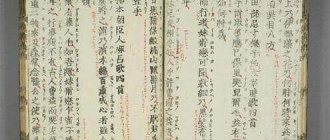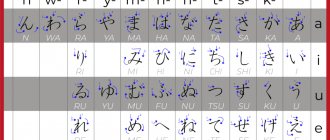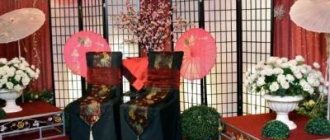Japanese bath and genkan
This article will not include a historical sketch; we will only look at modern and relatively new Japanese housing.
But instead of an introduction, we would like to draw attention to 2 things that will certainly catch the eye and may surprise a person unfamiliar with Japanese culture: ofuroba (お風呂場) and genkan (玄関).
Ofuroba is a Japanese bathroom, the main feature of which is that you can take a shower directly on the floor and spray water in any direction without fear of flooding - in Japanese bathrooms the drainage drain is built into the floor.
For this reason, most ofuros are located at a level above the floor; to enter the bathroom we literally have to climb a step higher
Genkan is a special area at the entrance to every Japanese home where it is customary to leave your shoes. A peculiar mixture of threshold, porch and hallway.
In Europe it is also common to take off your shoes when entering a home, but in Japan this area is more visible and is usually located a level lower than the rest of the floor.
Moisture absorber
It is one of the most popular household products in Japan. The climate there is very humid, and therefore people have to constantly fight mold. These small devices can be found literally in every corner of the house: in cabinets, chests of drawers and even on window sills.
View this post on Instagram
? The compact moisture absorber Deerma is what you need for rooms oversaturated with moisture, which will take care of preserving your household appliances from the formation of mold and rust. The main drying element is high molecular weight balls, thanks to micropores on the surface of which water molecules are attracted. ? The Deerma dehumidifier is equipped with densely spaced drying holes, which increases the working area to 385 cm2. ? Two plate-shaped ceramic posistor heaters heat evenly and quickly, eliminating moisture and dampness, and are suitable for safe use at home, office and any other places. ? #air dehumidifier #moisture absorber #indoor humidity #air humidity
A post shared by Xiaomi Crimea (@mi92.ru) on Aug 11, 2021 at 9:51am PDT
Japanese apartment layout
As soon as you open any housing search site - be it in English or Japanese, you will immediately notice: 1DK, 2LDK, 1K and other terrible abbreviations. Why is that?
In Japan, English abbreviations are used to indicate the number of rooms, or rather the type of living space in an apartment. But as with most words of the wasei-eigo type (Japanese “pseudo-anglicisms”), they are not particularly common outside of Japan.
The main abbreviation that is worth remembering is the abbreviation LDK from the English 'living-dining-kitchen', that is, “kitchen-dining-living room”. In Japan, the LDK is the center of your home, an open living space combined with a kitchen.
European studio apartments are perhaps the most consistent with the very concept of LDK, except that in Japan all the premises are, of course, much smaller.
We devoted a separate paragraph to footage, because this is not easy in Japan either.
Japanese residential buildings near Nogizaka Station (乃木坂駅)
Japan has different ideas about comfort
– Michigami-san, what aspects of the real estate market interest you in Russia?
– When I ask Russians about housing, I understand that this is still a difficult topic for them. Mortgages have appeared in the country, many new houses have sprung up, there is a secondary market and rental housing. Why does housing remain a problem for many in the country? I am interested in almost everything: property issues and the right of residence; the situation of those who took out a mortgage in foreign currency; who sets property taxes and how; special housing for the elderly; suburban housing market. All this is interesting and very different from the way people live in Japan. In many respects, our two markets cannot be compared with each other.
– Do the Japanese prefer to rent housing or buy their own?
– In Japan, 60% of housing is owned, along with the land, the remaining 40% is rented out. Of course, a lot depends on where the housing is located. Central Tokyo is so expensive that it is better to rent an apartment there. In Niigata, where I live, buying your own home is relatively easy. Therefore, residents of the provinces more often choose property, while residents of the capital choose renting. The reason why Japanese people strive to own a home lies in our character. For example, it is fundamentally important for my parents to have their own house and land. Rental housing is someone else's space. In addition, we can use housing as an investment or capital: rent it out and receive income. In addition to the value system, a very cheap mortgage contributes to the purchase of your own home. It is issued for 35 years at 1–2% per annum. Now this is the market rate, but previously the government subsidized it. For 15 years from the mid-1990s, rates remained almost zero, but even now they are quite affordable.
– What proportion of home buyers take out a mortgage?
- Almost everything. In Japan, in principle, lending in foreign currency is possible, but mortgages are always given in yen, since it is impossible to calculate exchange rate risks 35 years in advance. According to statistics, the average Japanese household has approximately 12 million yen in savings. And another 6–7 million in accumulated debt to banks. The bulk of this debt comes from mortgages. Since there are approximately twice as many savings as debts, the borrower is insured against personal bankruptcy. Japanese banks believe that up to 30% of a family's income can be used to pay off a loan. It should be borne in mind that in Russian families, as a rule, there are two working spouses, and in Japan - one. And a slightly different consumption structure.
– What size housing can the average Japanese family afford to buy?
– In Japan, it is not customary to divide housing into economy, comfort and business class, as in Russia. There is some social housing. But the real market is divided into two large segments: apartments and detached houses. These segments are related, but work completely differently. In Tokyo, on average, 6,000–7,000 apartments come up for sale per year. They are approximately the same in terms of comfort. The price depends on the area (it is measured in both tatami and square meters) or on the number of rooms. On average, a Tokyo family most often buys an apartment measuring 70–80 sq.m. Its price is about 50 million yen (now about $450,000). Really affordable housing for the middle class is considered to be a wooden house with an area of 120–140 sq.m. It is built on a plot of 200 sq.m. and is sold together with the land. The land plot and the house have approximately the same share in the cost of the transaction. It makes no sense to calculate the average price in this segment, because the price of land can vary radically depending on the area in which the plot is located. Wealthy people, as elsewhere, prefer to settle separately and form their own neighborhoods. In addition, the market price of a home depends greatly on when the building was built. In Japan, the service life of a residential building is 50 years. Depreciation of real estate must be taken into account.
– Do young Japanese, after finishing their studies, prefer to rent an apartment until they start a family? Or are they immediately focused on buying their first home?
- Differently. This depends not so much on the age at which a young man starts a family, but on whether he has a permanent job in a serious company. While he is looking for such a job, he must remain mobile. When it appears, you can think about your own home. A permanent employee can easily get a mortgage. The real estate market is impacted by Japan's aging population. Special real estate for the elderly is in demand - with special bathrooms, without thresholds, with elevators adapted to the size of a wheelchair. There are more and more such housing.
– And yet the most economically accessible is mass low-rise construction?
– Yes, and it’s surprising to me that the cheapest housing in St. Petersburg is in 25-story buildings. It seems to me that in a couple of decades there will be huge problems with the operation of these houses, with the supply of water and heat upstairs. In Japan, a developer takes a territory, cuts it into plots of 200 square meters, develops an entire block and builds a residential complex that consists of private houses. Typically such an area includes schools, shopping centers, a hospital and is formed around a railway station. Private railway companies that build new lines and stations serve as real drivers of territorial development. In our country, railway transport accounts for the largest share of passenger traffic within cities. Several office high-rises are being built around the station on special cushions that protect buildings from earthquakes. Next, shopping streets are formed, and behind them is a huge array of private houses. For Japan, this is the most economical model, best adapted to market conditions.
– Would Japanese companies like to implement something similar in Russia?
- Maybe. Although construction technologies in this case will require some modification. Japan has different ideas about the quality of housing. A newly built house has neither heating nor air conditioning; the owner must take care of this himself. Most Japanese are willing to tolerate the cold, but not the heat. Japan receives enormous amounts of rainfall. That's why our houses have excellent waterproofing. But double glazing is still a luxury. Note that people never enter a Japanese home wearing shoes. There is a step leading into the house, which you climb up, leaving your shoes at the bottom. This place is called genkan - analogous to your hallway.
– How, with such a love for traditional private houses, do you create cities with a high population density?
– Japanese cities occupy a larger territory than Russian cities with a similar population. Several cities merge into a single metropolis. If we look at the agglomeration that unites Kyoto, Osaka, Kobe, Nara, we will see that 17 million people live in a relatively small area and produce a GDP equal to the GDP of Canada. It is truly a gigantic concentration of people and economic activity. It is achieved due to the fact that there are no borders between cities, and from the center of one to the center of another you can get by train in half an hour.
– How does housing renovation occur when its service life expires?
– In Japan, each owner renovates a house from his own budget. And this is a very serious problem. The population is shrinking and aging. Japanese pensions are not so large that they can be invested in upgrading a house or apartment. Sometimes this is done on credit, sometimes children help. It is more convenient for developers to tear down private houses with an excavator and build a new residential area. The business model is focused on the complete renovation of a residential area; this approach provides maximum profit. But for the owners this is a big expense, although the land remains their property, i.e. they only need to build a house. Renovation of mass multi-storey buildings follows the same pattern. There is no point in leaving the walls: seismic resistance standards have changed dramatically in 40 years. It is better for the owners to leave, let the developers build new apartments and then sell them or, if they have enough money, move into the renovated housing themselves. It will, of course, be more expensive than before. It helps that Japan has very low inflation. Contributions for the reconstruction of the house begin to be collected right from the moment it is put into operation. As a result, large sums accumulate. Land in 40 years can also increase in price. But there are still few examples of mass renovation that would suit everyone. In 1996, after the great Kobe earthquake, new neighborhoods were built ahead of schedule. But housing prices have risen so much that they are beyond the capabilities of ordinary people.
– What if the owners do not agree to renovation? Can the state or municipality carry it out by force?
- No. In Japan, mechanisms for influencing owners are only now appearing. Every eighth private house in cities is empty or even falling apart. The owners are not going to repair or demolish them, because demolition also costs money - about $20,000. Now, some municipalities have begun to pass local laws that can force the owner to demolish the house or pay the costs of demolition. But such laws have not yet been adopted for apartment owners in high-rise buildings.
– Are there any restrictions for foreigners related to purchasing real estate in Japan?
– As far as I know, there are no legal restrictions. A foreigner can buy both a house and the land underneath it. The only question is emotions: will he be able to get used to the peculiarities and customs of our country.
The editors would like to express their gratitude to the First Deputy Dean of the Faculty of Economics of St. Petersburg State University A. V. Belov for his assistance in organizing and conducting the interview.
What is 1LDK
The number before the abbreviation LDK usually means the number of actual separate rooms that we will find in the apartment in addition to the kitchen-dining-living area. Simply put, this is the number of bedrooms.
If the apartment has a 1LDK layout, then we will find
- 1 living space of the “kitchen-dining-living room” type
- 1 bedroom
If the apartment has a 2LDK layout, then accordingly:
- 1 living space of the “kitchen-dining-living room” type
- 2 bedrooms
Accordingly, 1LDK can be called a 2-bed apartment, where the kitchen and living room are combined. Apartment type 1LDK will most likely be the minimum that most people moving from Europe to Japan will agree to.
The average size of such housing is approx. 25-35 square meters in.
Is it possible even less? Can
Bathrooms
The culture of water procedures in Japan is very developed. Before taking a bath, the Japanese first wash themselves in the shower and then lie down in the bath. The new equipment does not have taps; the entire process is controlled using a special panel, where you can even set the water temperature. The same system controls the water in the drains, so water from the bath can then be directed to the washing machine. Such is the saving.
View this post on Instagram
Who else can pack so many jets into a 1250mm long Deep Soaking Bath?
A post shared by Omnitub (@omnitubuk) on Oct 15, 2021 at 3:59am PDT
Layout 1DK, 1K, 1R
Layout 1DK, as you can more or less understand from the name, is a more compact version of LDK. Simply put, we still have one bedroom at our disposal, but since the living space of the LDK type is much smaller, it can hardly be called a living room, so instead of LDK we get DK.
In an apartment with a 1DK layout, then to the apartment we will find
- 1 living space of the “kitchen-dining room” type
- 1 bedroom
An even smaller apartment, where there is no space for a dining room, but the kitchen is still located separately, is usually designated as 1K, that is, without a dining room.
In an apartment with a 1K layout, we will find:
- 1 separate kitchen
- 1 bedroom
Most in Japan, 1DK apartments are still converted into a mini-living room with a TV. Remember that such a division can most often be quite conditional, and the apartment may not have walls in our understanding of the word. The premises will be separated by sliding partitions.
The average size of housing type 1DK is approx. 23-30 square meters.
In general, in Tokyo you can find housing even measuring 10-15 square meters. In this case, a small kitchen will be immediately at the entrance, in fact, in the same room as our only room.
For this type of housing, a special abbreviation 1R (R means room, respectively).
SLDK and other options
In addition to the traditional 1LDK, 2LDK, 3LDK, we can find another abbreviation 3SLDK. In this case, S means “storage room” or “service room”.
In most cases, such an additional room is theoretically a storage room, closet or closet and can easily be transformed into another bedroom. But since the size of such a room can still vary depending on the layout of a particular apartment, there is no guarantee.
But if we are looking for housing of the 4LDK type, then perhaps the 3SLDK option will also be suitable.
That same bedroom is 6 jo in size











